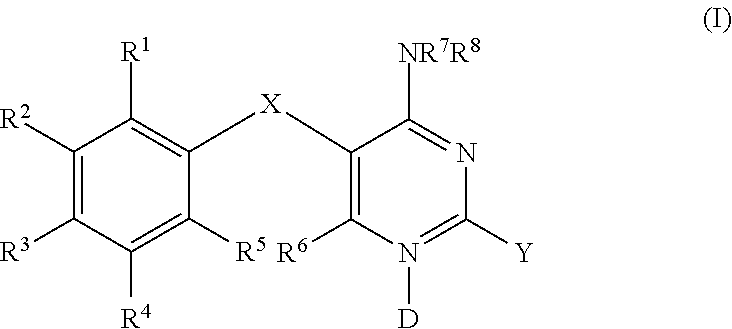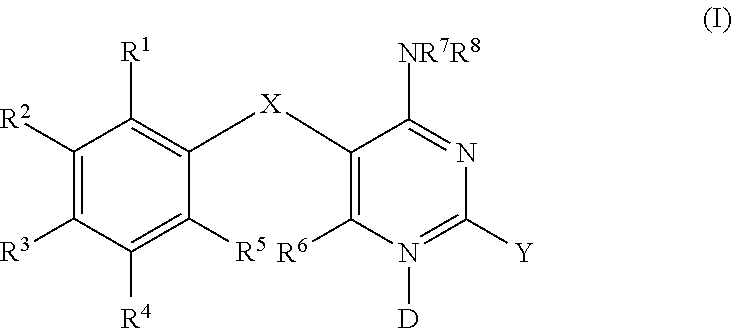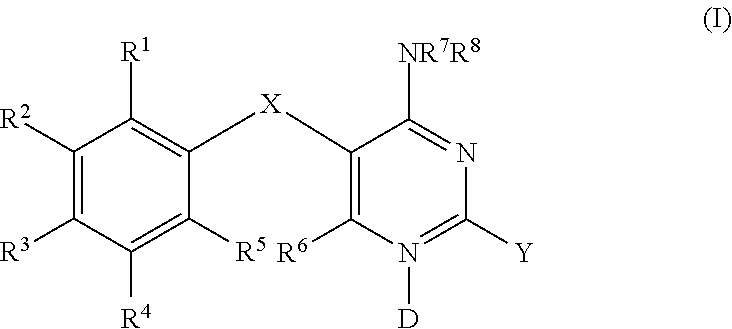Methods of using diaminopyrimidine as p2x3 and p2x2/3 receptor modulators for treatment of respiratory and gastrointestinal diseases
a technology of p2x3 and p2x2/3 receptors, applied in the field of compounds and methods for treating diseases associated with p2x purinergic receptors, can solve the problems of intense pain and pronounced increase of sensory nerve discharg
- Summary
- Abstract
- Description
- Claims
- Application Information
AI Technical Summary
Benefits of technology
Problems solved by technology
Method used
Image
Examples
examples
[0321]The following preparations and examples are given to enable those skilled in the art to more clearly understand and to practice the present invention. They should not be considered as limiting the scope of the invention, but merely as being illustrative and representative thereof.
preparation 1
N-(2-(R)-Hydroxy-1-methyl-ethyl)-guanidine
Step 1 Bis-benzyloxycarbonyl-N-(2-(R)-Hydroxy-1-methyl-ethyl)-guanidine
[0322]
[0323]To a solution of R-(−)-2-amino-1-propanol (0.59 g, 8.0 mmol) in 50 mL THF was added pyrrazole carboxamidine (3.0 g, 8.0 mmol, prepared as described by M. S. Berbatowicz et al., Tetrahedron, 34 1993 p. 3389). After 16 hours the mixture was concentrated in vacuo. Purification via flash chromatography (93:7 ethyl acetate / CH2Cl2) afforded bis-benzyloxycarbonyl-N-(2-(R)-hydroxy-1-methyl-ethyl)-guanidine (3.0 g, 97%) as a white solid.
Step 2 N-(2-(R)-Hydroxy-1-methyl-ethyl)-guanidine
[0324]
[0325]To a solution of bis-benzyloxycarbonyl-N-(2-(R)-hydroxy-1-methyl-ethyl)-guanidine in 75 mL EtOH was added 10% Pd / C (0.10 g). The mixture was stirred under 1 Atmosphere of H2. After 16 hours the mixture was filtered through a pad of celite and concentrated in vacuo to give N-(2-(R)-hydroxy-1-methyl-ethyl)-guanidine (0.44 g, 69%).
[0326]Using the appropriate amines with the above...
example 1
5-[4,5-Dimethoxy-2-(1-methyl-2-phenyl-ethyl)-benzyl]-pyrimidine-2,4-diamine
[0335]The synthetic procedure used in this Example is outlined in Scheme D.
Step 1. 2-[4,5-Dimethoxy-2-(1-methyl-2-phenyl-ethyl)-phenyl]-4,4-dimethyl-4,5-dihydro-oxazole
[0336]The 4,4-dimethyl-2-(2,4,5-trimethoxy-phenyl)-4,5-dihydro-oxazole oxazoline used in this step was prepared according to the procedure reported by Meyers, A. I. et al., J Org Chem 43 1978, pp. 1372-1379.
[0337]To a rapidly stirring suspension of magnesium turnings (1.32 g, 54.5 mol) and in 35 mL tetrahydrofuran (THF) was added 1,2-dibromoethane (0.10 mL) in one portion. 2-bromo-1-phenylpropane (10.86 g, 54.5 mmol) was added at a rate that maintained the internal temperature at 40° C. After 2.5 hours the cloudy suspension was transferred via canula to a solution of 4,4-dimethyl-2-(2,4,5-trimethoxy-phenyl)-4,5-dihydro-oxazole oxazoline (10.013 g, 36.4 mmol) in 50 mL THF. After 18 hours the solution cooled to 0° C. and quenched by the slow addi...
PUM
 Login to View More
Login to View More Abstract
Description
Claims
Application Information
 Login to View More
Login to View More - R&D
- Intellectual Property
- Life Sciences
- Materials
- Tech Scout
- Unparalleled Data Quality
- Higher Quality Content
- 60% Fewer Hallucinations
Browse by: Latest US Patents, China's latest patents, Technical Efficacy Thesaurus, Application Domain, Technology Topic, Popular Technical Reports.
© 2025 PatSnap. All rights reserved.Legal|Privacy policy|Modern Slavery Act Transparency Statement|Sitemap|About US| Contact US: help@patsnap.com



